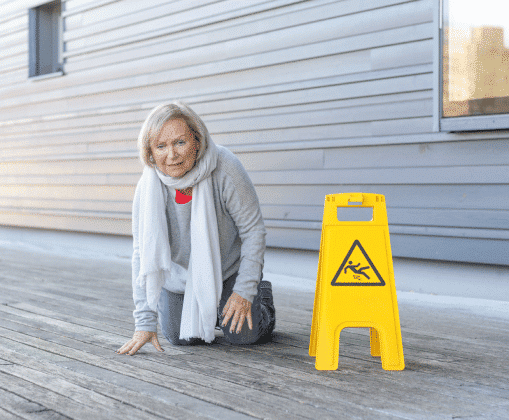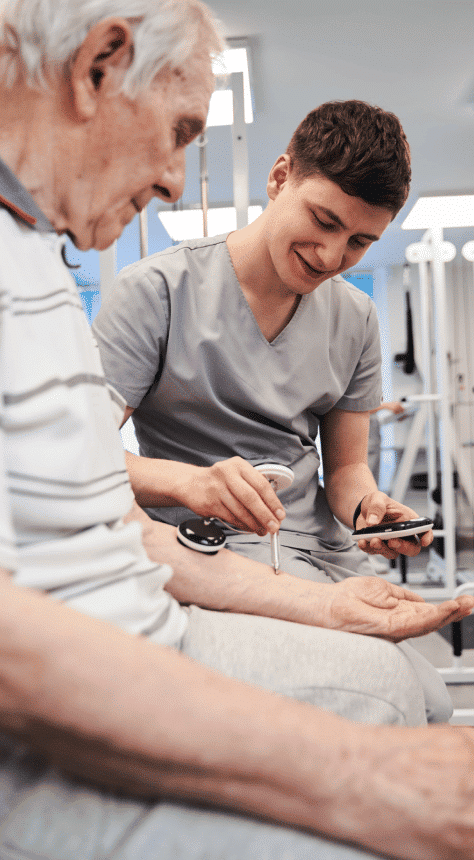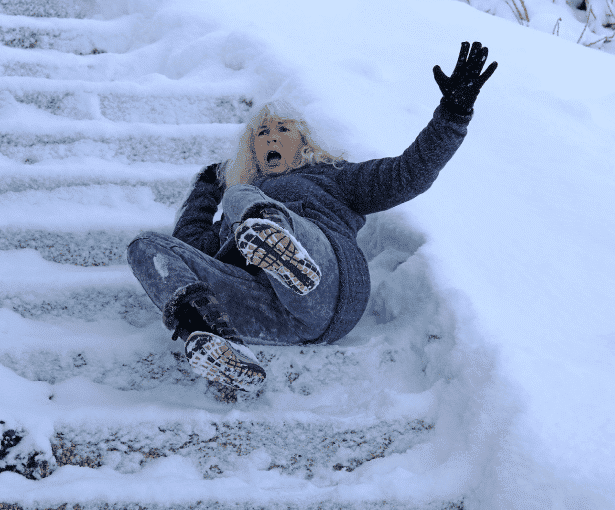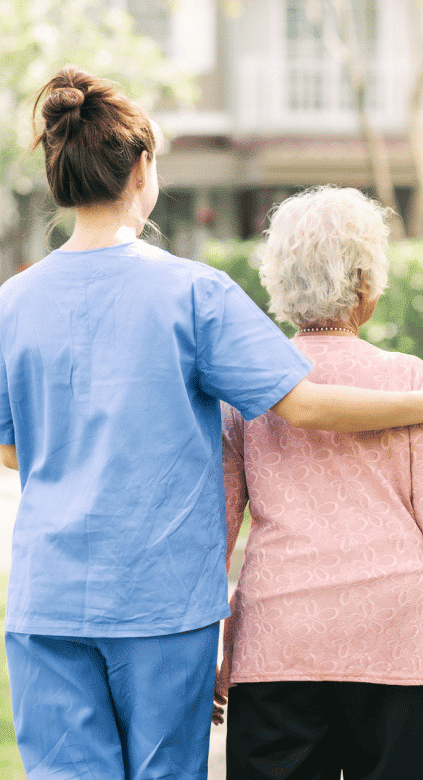Home Elderly Slips and Falls Guide
ELDERLY SLIPS AND FALLS GUIDE
Elderly fall victims are susceptible to a wide range of debilitating injuries, including brain injuries and fractured hips, wrists, knees, and other broken bones. Sadly, many elderly fall victims don’t survive their injuries. Nationwide, 34,000 fatal falls among the elderly were recorded in 2019.
In 2019, more than 3 million elderly Americans visited the emergency room because of fall-related injuries. That breaks down to five or six falls every minute. Data suggests women are hospitalized after a fall at twice the rate of men. Many of these falls are quite serious.
Falls can have serious physical, emotional, and financial repercussions for elderly fall victims and their families. The CDC estimates that falls cost about $50 billion in medical bills annually.
So, why are seniors slipping and falling at such alarming rates? And what can be done to limit the chances of you or someone you care about falling and getting hurt? Brown & Crouppen in Kansas City tackles these important questions and others in our slip-and-fall guide for the elderly.

WHY ARE SENIORS PRONE TO FALLING?
As we age, we become more susceptible to falling and sustaining severe injuries. Risk factors that increase the odds of elderly adults slipping and falling include the consequences of the natural aging process, such as poor vision and reduced muscle mass, as well as a person’s surroundings.

VISION PROBLEMS
It is common for eyesight and vision to deteriorate over time. Limited visibility or blurred vision can make it more difficult to see where we are going, which increases the risk of tripping over an object or slipping on a slick surface.


HEALTH CONDITIONS
Many health conditions can adversely affect our sense of balance and reflexes, making it more difficult to remain upright or grab onto an object to help steady us before a fall.
Health issues that might increase the likelihood of falling include:
- Parkinson’s disease
- Arthritis
- Diabetes
- Thyroid disease
- Vertigo
- Alzheimer’s disease
- Dementia
- Incontinence
- Dehydration
- Hypotension (low blood pressure)
- Heart disease
- Bradycardia
- Irregular heart rate
- Vitamin D deficiency
Often, older Americans find themselves taking several medications to manage these (and other) medical conditions. However, sometimes those medications can be a risk factor for common causes of slip and falls too.

MEDICATIONS
All pharmaceutical medications have side effects. Specific types of medications — including sedatives, insulin, antidepressants, and antipsychotics — can substantially increase the risk of a fall.
Some of the most common side effects include dizziness, confusion, low blood pressure, high blood pressure, and low blood sugar, all of which can increase the likelihood that an elderly person will fall.
The risk increases with each additional medication a person takes.

SARCOPENIA (REDUCED MUSCLE MASS)
Studies suggest that muscle mass decreases by about 3 percent to 8 percent every decade after a person turns 30 — and diminishes at a higher rate after the age of 60. As we lose muscle mass, we lose strength. When our core and limbs degenerate, we experience weakness and may have difficulty moving. In turn, we become more susceptible to falls.
Not only does reduced muscle mass increase the risk of falling, but it also increases the likelihood of sustaining severe injuries. Loss of muscle mass is associated with decreases in bone density and joint stiffness. In a fall, bones and joints are more susceptible to fractures and trauma.

PAIN IN THE FEET AND LEGS
When it becomes more difficult or painful to stand or walk, we become more susceptible to falls. The elderly may experience pain in the feet and legs due to improper footwear, improperly healed fractures or injuries, edema (swelling in the legs), or blood clots.

ENVIRONMENTAL FACTORS
Even a healthy and alert person can slip, trip, and fall under the right circumstances. Often, environmental factors contribute to these types of fall accidents. Environmental risk factors might include:
- Loose electrical wires
- Loose carpeting or rugs
- Spills or liquid on the floor
- Uneven floor or ground surfaces
- Ice or snow
- Cluttered home environments
- Inadequate lighting
- Sometimes mobility enhancement devices, such as canes or walkers, can contribute to a fall if used improperly.
LIFESTYLE CHANGES MAY PREVENT SLIPS AND FALLS
Research clearly shows that age- and health-related risk factors increase the likelihood of slipping and falling or tripping and falling as we get older. Ultimately, investing in your overall health and well-being is the best way to prevent a fall. Exercise and a healthy diet can help you decrease your chances of falling.

EXERCISE REGULARLY
Don’t let the fear of falling stand between you and a regular workout routine. If you do nothing else, exercise. Regular exercise can:
- Decrease the chances of developing health conditions that lead to falls
- Improve muscle mass, bone density, balance, and strength
- Increase blood flow and encourage regular detoxification
- Improve memory and cognitive function
Don’t overdo it, but don’t be afraid to mix up your workout routine. Performing a variety of different exercises — including strength training, cardio, and low-intensity activities like yoga — comes with benefits.
EAT A HEALTHY AND BALANCED DIET
Exercise and diet go hand in hand. What you eat will either help you grow or contribute to your health’s decline. And a poor diet is the fastest way to sabotage the headway you make with your exercise routine.
Research suggests that maintaining a healthy plant-based diet can prevent or reverse chronic health problems and eliminate the need for certain prescription medications, including many that increase the risk of falling.
For the best health outcomes, avoid highly processed or artificial foods. Incorporate a lot of vegetables and fruits. Don’t shy away from healthy starches and fats. Do your best to eat organic foods, as conventional foods tend to be laden with heavy metals, pesticides, and other contaminants that can do considerable damage to your health.
Of course, it is all about balance and moderation. Sticking to a healthy diet doesn’t mean cutting out everything that is less than 100 percent healthy.
LIMIT TOBACCO AND ALCOHOL USE
Studies show that consuming tobacco and alcohol can have many adverse health effects on the body — including the loss of bone mineral density. Frequent or consistent smoking or drinking can potentially increase the risk of osteoporosis and, in turn, falls.
GET OUTSIDE
Don’t shy away from the sun. Vitamin D deficiencies are linked to decreases in bone mineral density and overall bone health. When bones are frail, they are less likely to support the body’s weight and more likely to fracture in a fall. The best possible source of Vitamin D is the sun — so get outside for daily doses whenever possible. But make sure you wear sunscreen.
SEEK CARE SUPPORT
It is always okay to ask for help. If you believe that you might be a fall risk, ask friends, family members, or caregivers for assistance in making your home as safe as possible. You can also hire a home health services agency to address the safety challenges that come with aging. Consider getting a fall detection device such as Medical Guardian, LifeFone, or Lifeline.
OTHER TIPS TO PREVENT SLIPPING AND FALLING
While investing in your health and making lifestyle changes can reduce the risk of slips and falls, you can also take other steps to prevent these types of accidents.
- Get your vision and hearing checked regularly.
- Wear appropriate glasses and hearing aids at all times to stay alert and aware of your surroundings.
- Declutter your home.
- Clear walkways and spaces where you move frequently.
- Light your home properly, especially at the top and bottom of stairs.
- Use railings when climbing the stairs.
- Use nonskid aids on surfaces that are likely to get wet and slippery — such as the bathroom, kitchen, and garage.
- Wear shoes that fit. (Nonslip soles are a plus.)
- Wear socks with built-in grips.
- Keep objects you use daily within reach.
WHAT TO DO IF YOU SLIP AND FALL
Sometimes we can’t avoid slips and falls, despite the lengths to which we have gone to stay safe. In these situations, it is important to know what to do to limit the extent of your injuries and potential complications.
DO YOUR BEST TO STAY CALM
Falls can be scary, especially if you are home alone. However, try not to panic. You want to be as calm and collected as possible. If you get worked up and anxious, you could exacerbate your injuries or make it more difficult to get the help you need.
DON’T TRY TO GET UP OR MOVE RIGHT AWAY
You may have sustained internal trauma or broken bones. If this is the case, moving could make your injuries worse. Stay where you are and take an inventory of any pain or discomfort. You know your body best. Do you feel pain in your feet, legs, or trunk? Do you think you can get up and stand on your own or with assistance?

TRY TO STAND UP CAREFULLY WITH SUPPORT
If you think you can stand, roll to your side. Then slowly get onto your hands and knees. Look for a sturdy object to support your weight, and carefully pull yourself up. Once you are vertical, locate your cell phone and call for help.
CALL FOR HELP IF YOU ARE UNABLE TO MOVE
If you don’t think you can stand, try calling out for help from someone in your home. Don’t shy away from continually calling out for help or making noise — especially if you live in an apartment, condo, townhome, or another place with shared walls or close neighbors.
If you are alone and can reach a cell phone or fall detection device, call for help. If you are not near your phone or can’t reach it, try sliding across the floor to get close to it.
CAREGIVERS AND FALLS: WHAT TO DO IF SOMEONE IN YOUR CARE FALLS
If someone you are taking care of falls, the first thing to do is get to their side and call for help. Help them remain calm and assess the severity of their injuries. Don’t move them right away. Instead, ask them if they feel any pain and determine whether they can support their body weight if they stand or move.
If they have visible injuries, administer first aid before attempting to move them. If you suspect that their injuries are severe or you are afraid to move them, help them get into a comfortable position until paramedics or other medical professionals arrive.
If you determine that they can be moved, help them get up slowly by supporting their weight. Move them to a nearby chair or couch so they can get comfortable while help is on the way. Monitor them, and note any changes in their speech, alertness, or ability to communicate. Document complaints of pain, nausea, or dizziness, which could indicate serious head injuries.
Falls are a serious risk for older adults, and taking precautions against slips and falls is one way to ensure that seniors age without injury. For more information on preventing falls and avoiding additional injury after a fall, visit the CDC’s Stopping Elderly Accidents, Deaths & Injuries STEADI initiative. You’ll find resources to help you or your loved one remain healthy and independent.

